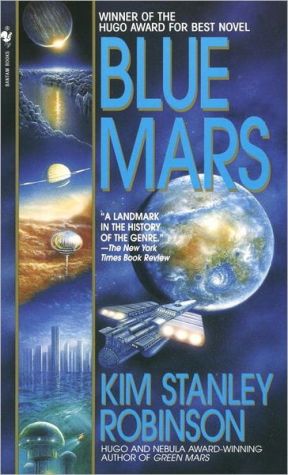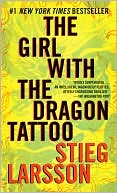Blue Mars
The red planet is red no longer, as Mars has become a perfectly inhabitable world. But while Mars flourishes, Earth is threatened by overpopulation and ecological disaster. Soon people look to Mars as a refuge, initiating a possible interplanetary conflict, as well as political strife between the Reds, who wish to preserve the planet in its desert state, and the Green "terraformers". The ultimate fate of Earth, as well as the possibility of new explorations into the...
Search in google:
The red planet is red no longer, as Mars has become a perfectly inhabitable world. But while Mars flourishes, Earth is threatened by overpopulation and ecological disaster. Soon people look to Mars as a refuge, initiating a possible interplanetary conflict, as well as political strife between the Reds, who wish to preserve the planet in its desert state, and the Green "terraformers". The ultimate fate of Earth, as well as the possibility of new explorations into the solar system, stand in the balance.Publishers WeeklyRed Mars, the kickoff to Robinson's epic Mars trilogy, won the Nebula for best SF novel of 1992; its follow-up, Green Mars, won the parallel Hugo for 1994. The conclusion to the saga is not unlike the terrain of Robinson's Red Planet: fertile and fully developed in some spots, vast and arid in othersbut, ultimately, it's an impressive achievement. Using the last 200 years of American history as his template for Martian history, Robinson projects his tale of Mars's colonization from the 21st century, in which settlers successfully revolt against Earth, into the next century, when various interests on Mars work out their differences on issues ranging from government to the terraforming of the planet and immigration. Sax Russell, Maya Toitovna and others reprise their roles from the first two novels, but the dominant "personality" is the planet itself, which Robinson describes in exhaustive naturalistic detail. Characters look repeatedly for sermons in its stones and are nearly overwhelmed by textbook abstracts on the biological and geological minutiae of their environment. Not until the closing chapters, when they begin confronting their mortality, does the human dimension of the story balance out its awesome ecological extrapolations. Robinson's achievement here is on a par with Bradbury's The Martian Chronicles and Herbert's Dune, even if his clinical detachment may leave some readers wondering whether there really is life on Mars. Author tour. (June)
At a certain moment before dawn the sky always glowed the same bands of pink as in the beginning, pale and clear in the east, rich and starry in the west. Ann watched for this moment as her companions drove them west, toward a mass of black land rearing into the sky—the Tharsis Bulge, punctuated by the broad cone of Pavonis Mons. As they rolled uphill from Noctis Labyrinthus they rose above most of the new atmosphere; the air pressure at the foot of Pavonis was only 180 millibars, and then as they drove up the eastern flank of the great shield volcano it dropped under 100 millibars, and continued to fall. Slowly they ascended above all visible foliage, crunching over dirty patches of wind-carved snow; then they ascended above even the snow, until there was nothing but rock, and the ceaseless thin cold winds of the jet stream. The bare land looked just as it had in the prehuman years, as if they were driving back up into the past. It wasn't so. But something fundamental in Ann Caybome warmed at the sight of this ferric world, stone on rock in the perpetual wind, and as the Red cars rolled up the mountain all their occupants grew as rapt as Ann, the cabins falling silent as the sun cracked the distant horizon behind them.\ Then the slope they ascended grew less steep, in a perfect sine curve, until they were on the flat land of the round summit plateau. Here they saw tent towns ringing the edge of the giant caldera, clustered in particular around the foot of the space elevator, some thirty kilometers to the south of them.\ They stopped their cars. The silence in the cabins had shifted from reverent to grim. Ann stood at one upper-cabin window, looking south to Sheffield, that child of the space elevator: built because of the elevator, smashed flat when the elevator fell, built again with the elevator's replacement. This was the city she had come to destroy, as thoroughly as Rome had Carthage; for she meant to bring down the replacement cable too, just as they had the first one in 2061. When they did that, much of Sheffield would again be flattened. What remained would be located uselessly on the peak of a high volcano, above most of the atmosphere; as time passed the surviving structures would be abandoned and dismantled for salvage, leaving only the tent foundations, and perhaps a weather station, and, eventually, the long sunny silence of a mountain summit. The salt was already in the ground.\ *\ • *\ A cheerful Tharsis Red named Irishka joined them in a small rover, and led them through the maze of warehouses and small tents surrounding the intersection of the equatorial piste with the one circling the rim. As they followed her she described for them the local situation. Most of Sheffield and the rest of the Pavonis rim settlements were already in the hands of the Martian revolutionaries. But the space elevator and the neighborhood surrounding its base complex were not, and there lay the difficulty. The revolutionary forces on Pavonis were mostly poorly equipped militias, and they did not necessarily share the same agenda. That they had succeeded as far as they had was due to many factors: surprise, the control of Martian space, several strategic victories, the support of great majority of the Martian population, the unwillingness of the United Nations Transitional Authority to fire on civilians, even when they were making mass demonstrations in the streets. As a result the UNTA security forces had retreated from all over Mars to regroup in Sheffield, and now most of them were in elevator cars, going up to Clarke, the ballast asteroid and space station at the top of the elevator; the rest were jammed into the neighborhood surrounding the elevator's massive base complex, called the Socket. This district consisted of elevator support facilities, industrial warehouses, and the hostels, dormitories, and restaurants needed to house and feed the port's workforce. "Those are coming in useful now," Irishka said, "because even though they're squeezed in like trash in a compactor, and if there hadn't been food and shelter they would probably have tried a breakout. As it is things are still tense, but at least they can live."\ It somewhat resembled the situation just resolved in Burroughs, Ann thought. Which had turned out fine. It only took someone willing to act and the thing would be done—UNTA evacuated to Earth, the cable brought down, Mars's link to Earth truly broken. And any attempt to erect a new cable could be balked sometime in the ten years of orbital construction that it took to build one.\ So Irishka led them through the jumble that was east Pavonis, and their little caravan came to the rim of the caldera, where they parked their rovers. To the south on the western edge of Sheffield they could just make out the elevator cable, a line that was barely visible, and then only for a few kilometers out of its 24,000. Nearly invisible, in fact, and yet its existence dominated every move they made, every discussion—every thought they had, almost, speared and strung out on that black thread connecting them to Earth.
\ Publishers Weekly - Publisher's Weekly\ Red Mars, the kickoff to Robinson's epic Mars trilogy, won the Nebula for best SF novel of 1992; its follow-up, Green Mars, won the parallel Hugo for 1994. The conclusion to the saga is not unlike the terrain of Robinson's Red Planet: fertile and fully developed in some spots, vast and arid in othersbut, ultimately, it's an impressive achievement. Using the last 200 years of American history as his template for Martian history, Robinson projects his tale of Mars's colonization from the 21st century, in which settlers successfully revolt against Earth, into the next century, when various interests on Mars work out their differences on issues ranging from government to the terraforming of the planet and immigration. Sax Russell, Maya Toitovna and others reprise their roles from the first two novels, but the dominant "personality" is the planet itself, which Robinson describes in exhaustive naturalistic detail. Characters look repeatedly for sermons in its stones and are nearly overwhelmed by textbook abstracts on the biological and geological minutiae of their environment. Not until the closing chapters, when they begin confronting their mortality, does the human dimension of the story balance out its awesome ecological extrapolations. Robinson's achievement here is on a par with Bradbury's The Martian Chronicles and Herbert's Dune, even if his clinical detachment may leave some readers wondering whether there really is life on Mars. Author tour. June\ \ \ \ \ VOYA - William J. White\ In Red Mars (HarperCollins, 1992), Robinson began the story of the colonization of Mars in the late 21st century, at first by a group of one hundred carefully selected scientist-pioneers and later by additional groups of Japanese, Arab, and other settlers. The story detailed the process of exploration and settlement, and the conflicts among the colonists, some of whom who desired to terraform the planet as quickly as possible and others who wished to leave it in its pristine condition to study. Additionally, as transnational corporations grew in power back on Earth, tension between them and the colonists also rose, ultimately leading to an unsuccessful bid for independence by the Martian settlers. Green Mars (HarperCollins, 1993/VOYA, October 1994) continued the story, depicting the emergence of a new Martian culture and the subsequent successful rebellion of the colonists. Finally, in Blue Mars, the colonist, having won their independence from Earth, must resolve questions of how they will govern themselves, the nature of their relationships with Earth, and their relationship with their adopted homeworld. Robinson's Martian trilogy is a carefully crafted, mature piece of work that combines the science of hard SF with careful and creative social speculation. It evokes some of the best work in this subgenre, particularly Heinlein's The Moon is a Harsh Mistress (Putnam, 1966). Additionally, the characters are well-crafted and fully fleshed out, with human drives, desires, fears, and ambitions, and with histories together that are rich and warm and at the same time fueled with conflicts and complex rivalries. By the third volume, it is possible to identify characters by their distinctive voices even before they are named, so well has Robinson brought us into their world and into their heads. This is an ambitious and outstanding trilogy; Blue Mars is the capstone of Robinson's achievement. If it is disappointing in any way, it is only in that Robinson's Mars has been so completely explored as to leave no doubt that the story is finished. VOYA Codes: 4Q 4P J S (Better than most, marred only by occasional lapses, Broad general YA appeal, Junior High-defined as grades 7 to 9 and Senior High-defined as grades 10 to 12).\ \ \ Library JournalThis third book in Robinson's hard-science Mars trilogy follows 1992 Nebula winner Red Mars (LJ 11/15/92) and 1994 Hugo winner Green Mars (LJ 3/15/94). In the 21st century, colonists almost succeed in terraforming Mars. While they fight for independence from Earth and attempt to avert a civil war, they find their new civilization threatened by an ice age. A well-written, thoughtful conclusion to the trilogy. Highly recommended for sf collections.\ \ \ \ \ Roland GreenThe title of the conclusion to Robinson's splendid Mars trilogy refers to the fact that the planet now has oceans. Seen from space, Mars has taken on the bluish hue of a water-rich world, except for the places where balloon-domes preserve the last Martian wilderness. The red-gone-blue planet is still, however, vitally linked to Earth, on which civilization is crumbling in the face of rising oceans, and resources are being diverted to projects in the Jovian and Saturnian systems. Further confounding Earth's confusion (not to mention Mars'), Mars now finds itself facing an ice age that could freeze all the hard-won water. The survivors of the First Hundred (Mars settlers, that is) and their Mars-born children face and largely win a last, desperate battle to save their new home and become true Martians. The virtues of "Blue Mars", amounting to a catalog of those of superior sf, hardly need to be repeated from reviews of its "Red" and "Green" predecessors, both of which have been award winners. Even if no more honors come its way, the trilogy here concluded indisputably stands in the forefront of two sf subgenres, Martian futurist visions and grand sagas of human evolution.\ \ \ \ \ Kirkus ReviewsThird in Robinson's hitherto stunning Martian trilogy (Red Mars, 1993; Green Mars, 1994). The terraforming of Mars proceeds, though, at the insistence of angry, isolationist Reds, more slowly; oceans, plants, and animals proliferate, while modified humans are able to live unprotected on the surface. As an amazingly diverse set of social systems evolves, the Martians buckle down to inventing a new and appropriate form of government. With the available longevity treatments, the population of Earth is soaring, raising the pressure to allow greater and more rapid immigration to Mars. Meanwhile, the invention of new propulsion units has opened up the outer solar system to development and colonization; even starships are now feasible. Those of the original Martian First Hundred that survive—a score or so—are all well over two hundred years old, experiencing memory problems and facing sudden, symptomless death. Many of the characters who were once bitter enemies—Red fanatic Ann, scientist Sax with his rebuilt brain, political manipulator Jackie—eventually become reconciled to one another. And the immigration crisis is resolved, this time without bloodshed, in a spirit of peace and cooperation. Mars, and perhaps the human species, has come of age.\ Robinson's brilliant extrapolations and fascinating speculations are the product of hard and deep thought, in disciplines ranging from politics and economics through physics to microbiology. But with only a handful of well-realized characters, no plot, and hardly any incidents, what he's written is more textbook than novel: a disappointment for readers anticipating a more resounding conclusion.\ \ \ \ \ \ From Barnes & NobleThe settlers of Mars have a choice: overpopulate their adopted planet with Earthlings fleeing great floods...or start an interplanetary war. The tale by a bioecology visionary is so plausible and scientifically sound that it reads like future history.\ \








